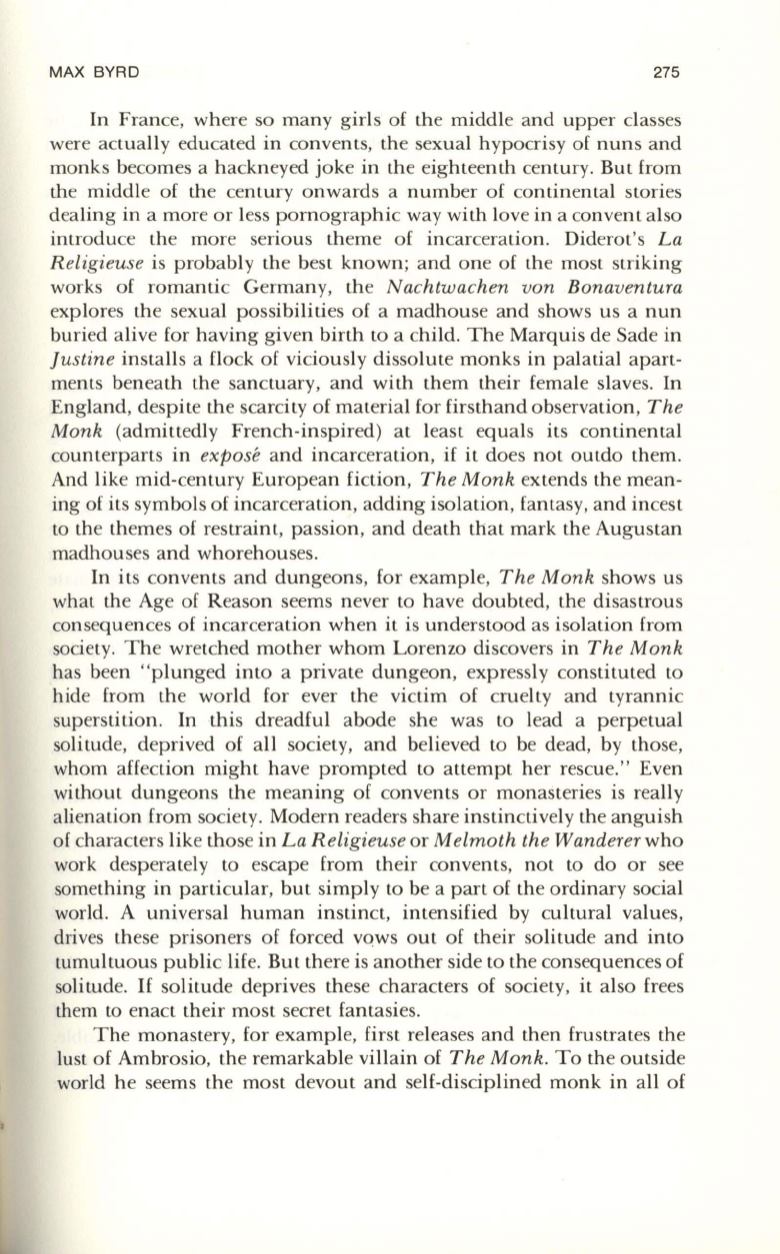
MAX BYRD
275
In
France, where so many girls of the middle and upper classes
were actually educated in convents, the sexual hypocrisy of nuns and
monks becomes a hackneyed joke in the eighteenth century. But from
the middle of the century onwards a number of continental stories
dealing in a more or less pornographic way with love in a convent also
introduce the more serious theme of incarceration. Diderot's
La
Religieuse
is probably the best known; and one of the most striking
works of romantic Germany, the
Nachtwachen von Bonaventura
explores the sexual possibilities of a madhouse and shows us a nun
buried alive for having given birth to a child. The Marquis de Sade in
Justine
installs a flock of viciously dissolute monks in palatial apart–
ments beneath the sanctuary, and with them their female slaves.
In
England, despite the scarcity of material for firsthand observation,
The
Monk
(admittedly French-inspired) at least equals its continental
counterparts in
expose
and incarceration, if it does not outdo them.
And like mid-century European fiction,
The Monk
extends the mean–
ing of its symbols of incarceration, adding isolation, fantasy, and incest
to
the themes of restraint, passion, and death that mark the Augustan
madhouses and whorehouses.
In
its convents and dungeons, for example,
The Monk
shows us
what the Age of Reason seems never to have doubted, the disastrous
consequences of incarceration when it is understood as isolation from
society. The wretched mother whom Lorenzo discovers in
The Monk
has been "plunged into a private dungeon, expressly constituted to
hide from the world for ever the victim of cruelty and tyrannic
superstition.
In
this dreadful abode she was
to
lead a perpetual
solitude, deprived of all society, and believed to be dead, by those,
whom affection might have prompted to attempt her rescue." Even
without dungeons the meaning of convents or monasteries is really
alienation from society. Modern readers share instinctively the anguish
of characters like those in
La Religieuse
or M
elmoth the Wanderer
who
work desperately to escape from their convents, not to do or see
something in particular, but simply to be a part of the ordinary social
world. A universal human instinct, intensified by cultural values,
drives these prisoners of forced
v~ws
out of their solitude and into
tumultuous public life. But there is another side to the consequences of
solitude.
If
solitude deprives these characters of society, it also frees
them to enact their most secret fantasies.
The monastery, for example, first releases and then frustrates the
lust of Ambrosio, the remarkable villain of
The Monk.
To the outside
world he seems the most devout and self-disciplined monk in all of


